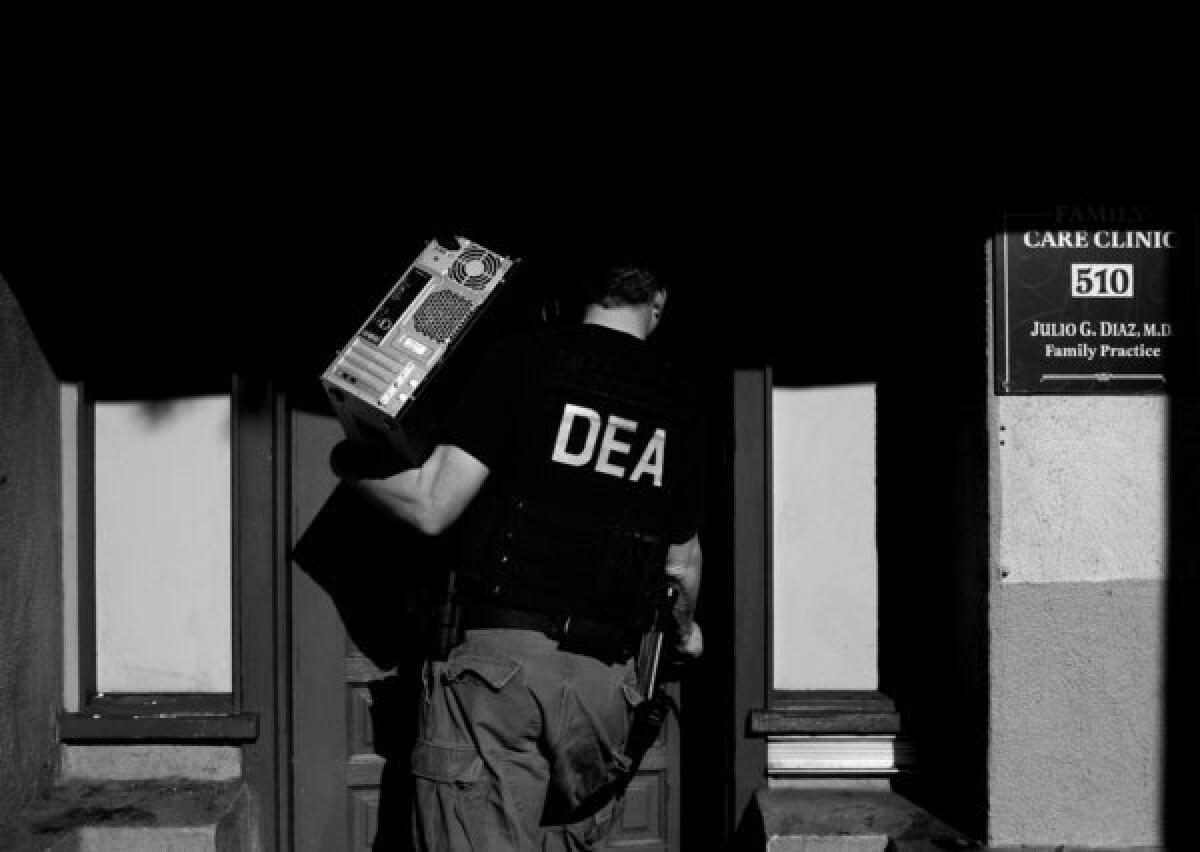Reckless doctors go unchecked
A database that could identify prolific prescribers and prevent overdose deaths is readily available, but California officials say they lack the resources to take advantage of it.

Dying for relief | A Times Investigation
Kamala Harris has a powerful tool for identifying reckless doctors, but she doesn't use it.
As California's attorney general, Harris controls a database
that tracks prescriptions for painkillers and other commonly abused drugs
from doctors' offices to pharmacy counters
and into patients' hands.
December 30, 2012

The system, known as CURES, was created so physicians and pharmacists could check to see whether patients were obtaining drugs from multiple providers.
Law enforcement officials and medical regulators could mine the data for a different purpose: To draw a bead on rogue doctors.
But they don't, and that has allowed corrupt or negligent physicians to prescribe narcotics recklessly for years before authorities learned about their conduct through other means, a Times investigation found.
Prescription drug overdoses have increased sharply over the last decade, fueling a doubling of drug fatalities in the U.S. To help stem the loss of life, the federal Centers for Disease Control and Prevention recommends that states use prescription data to spot signs of irresponsible prescribing, and at least six states do.
California is not one of them.
By monitoring the flow of prescriptions, authorities can get an early jump on illegal or dangerous conduct by a doctor. Among the telltale signs: writing an inordinate number of prescriptions for addictive medications or for combinations of drugs popular among addicts.
Harris' office keeps CURES off-limits to the public and the news media. But information from a commercial database containing the same kind of data illustrates how valuable CURES could be as an investigative tool.

Pills collected at death scenes await destruction in a coroner’s property room. Prescription overdoses have fueled a doubling of U.S. drug fatalities in the last decade. (Liz O. Baylen / Los Angeles Times)
Private firms purchase prescription data from pharmacies and sell it to drug companies for use in marketing their products. The Times obtained a list from such a database ranking the most prolific prescribers of narcotic painkillers in the Los Angeles area for June 2008.
Of the top 10 doctors on the list, six were eventually convicted of drug dealing or similar crimes or were sanctioned by medical regulators. One of them was a cocaine addict. Some had been prescribing narcotics in high volume for years before authorities caught up with them.
At least 20 of their patients died of overdoses or related causes after taking drugs they prescribed, according to coroners' records.
Had officials been tracking the doctors' prescriptions in CURES, some of those deaths might have been prevented.
Harris, a career prosecutor who was elected attorney general in 2010, declined repeated requests to be interviewed for this article.
Nathan Barankin, her chief of staff, said Harris wants to improve CURES so more doctors can use it to identify drug-seeking patients, and to help prosecutors pursue dealers and other drug offenders.
She has not proposed using CURES to detect signs of excessive prescribing.
Barankin said financial constraints limit the attorney general's options. CURES is "on life support" because of state budget cuts and is barely able to fulfill its primary mission of helping doctors and pharmacists track patients' use of medications, he said.
Even so, the database, as is, could be used to look for signs of improper prescribing. "It certainly has that capacity, as I understand it," Barankin said.
He added, however, that if Harris did begin using CURES to monitor doctors, the state Department of Justice lacks the resources to follow up on leads.
"We don't have the horses or the ability to do that kind of work," he said.
The Medical Board of California, which licenses and oversees physicians, has appealed to the public to report instances of excessive prescribing, a step it took in response to recent Times articles on overdose deaths.
But the board does not use CURES to identify doctors whose prescribing poses a danger to patients.
"We don't have the resources," said executive director Linda K. Whitney.
Voices

Dose of Reality
After a debilitating prescription drug overdose, Aaron Rubin warns audiences about the dangers of drug abuse.

Pills For Life
Injuries he suffered as a stuntman and in an auto accident left John Jackson dependent on prescription narcotics.

Another Day Without Alex
Their son's 2008 prescription drug overdose death is a painful legacy for Ron and Arline Clyburn.

Bitter Pills
In rehab, Edward Shut fights his addiction to prescription drugs.

Dr. Tyron Reece was one physician who would have tripped an alarm early on, if officials had been watching his prescriptions in CURES.
The Inglewood family practitioner ranked fourth among prescribers of oxycodone and hydrocodone in the Los Angeles area in June 2008, according to the commercial database. Reece's customers paid for nearly all those prescriptions in cash, the data show.
The pharmacies that filled Reece's prescriptions were required by law to report them to CURES.
But Reece was not stopped until 2011, and then only because federal authorities investigating a drug smuggling ring stumbled upon evidence that implicated him. Dozens of prescription vials bearing the doctor's name had been found in the trash at a suspect's home.
Confronted by investigators, Reece admitted that he regularly sold prescriptions for cash to patients he had never examined. He pleaded guilty to drug dealing and is awaiting sentencing.
Nathan Kuemmerle, a West Hollywood psychiatrist, was busted in 2010 after narcotics detectives arrested a suspect for selling prescription pills on Craigslist. The suspect identified Kuemmerle as the source of the drugs, court records show.
During their investigation, detectives requested a CURES report on Kuemmerle in 2009 and found that he was the No. 2 prescriber of narcotic painkillers in California and the No. 1 prescriber of the highest-dose form of the stimulant Adderall, according to court records.
Kuemmerle prescribed nearly four times as many of the Adderall pills as the next doctor on the list, the CURES report showed. A medical expert said Kuemmerle wrote an average of 15 prescriptions per day for controlled substances over a four-year period, a "remarkably high" figure, court records show.
Kuemmerle pleaded guilty in 2011 to drug dealing and was sentenced to three years' probation.
Investigators expressed amazement that Kuemmerle was able to get away with such high-volume prescribing while his prescriptions were being reported to CURES. The failure to use the database to look for signs of improper prescribing closes off a valuable source of leads, they say.
"If a doctor is prescribing in a way that could be considered unreasonable, there is nothing from CURES to say, 'This might be a problem,'" said Redondo Beach Police Det. Robert Carlborg, who worked on the case. "If there had been, Kuemmerle would have been caught way sooner."

On a warm October afternoon in 2003, Carmen Pack was taking her children to buy Slurpees in the Bay Area suburb of Danville.
Troy, 10, was on his scooter. Alana, 7, was riding her bike.
Heading toward them in a gold Mercedes was Jimena Barreto, a nanny for wealthy families in the area. She had been drinking and popping pills.
The Mercedes careened across two lanes of traffic. Alana was killed instantly. Troy died a few hours later.
Evidence emerged that Barreto was a "doctor shopper" who had obtained prescriptions for painkillers from half a dozen physicians at the same hospital. When the doctors testified at Barreto's trial, each said they didn't know about the others' prescriptions.
That exposed a problem that Bob Pack, the children's father, set out to remedy.
Pack, a technology entrepreneur, learned that California pharmacists were required to submit detailed data to the state on the controlled substances they dispensed. The information includes the name of the patient and the prescribing physician, as well as the drug and dosage.
The information is stored in the Controlled Substance Utilization Review and Evaluation System — CURES. The system has been in operation in various forms since 1939.
When Pack began studying CURES, doctors or pharmacists who suspected a patient of abusing drugs could call or fax requests to review the patient's history of filling prescriptions for narcotics. But it could take weeks before they received the desired information.
Pack devised a plan for real-time access to the database. He and some Silicon Valley friends helped design an Internet portal that would allow medical professionals to review a patient's history of medication use while considering whether to prescribe or dispense new drugs.
State officials embraced the idea.
Pack also pitched a separate component that would automatically alert state officials to doctors with suspicious prescribing patterns. In a recent interview, he called it a "built-in red flag system" that would deliver reports weekly or monthly.
Pack said he discussed the idea with then-Atty. Gen. Jerry Brown in 2007 and met regularly with state officials about the project for a couple of years.
At one meeting, in a demonstration of the database's potential, staff members presented Brown with a list of the 10 most prolific prescribers of narcotics in the state.
"Jerry Brown and his team were really into that," Pack recalled.
Brown announced the start of real-time access to CURES at a news conference in September 2009. Pack was at Brown's side as he touted the "high-tech monitoring system" that would "enable doctors and law enforcement to identify and stop prescription-drug seekers from doctor-shopping and abusing prescription drugs."

A federal agent removes a computer as evidence from a physician’s office. Data the state already collects could help authorities move sooner to stop reckless prescribers. (Liz O. Baylen / Los Angeles Times)
But the idea of using CURES to scrutinize doctors' prescribing was no longer part of the program. Pack attributed its disappearance to "a combination of apathy and a lack of funding."
Brown did not respond to requests for comment.
Pack, in an email, said "the idea was always there and still is, but the AG's office just needs to set it as a priority."

After Brown became governor in 2011, he eliminated the Bureau of Narcotics Enforcement, the unit that operated CURES, as part of his response to the state's financial crisis.
CURES is now run by a single full-time employee in the attorney general's office. A private company under contract with the state collects electronic reports on prescriptions from pharmacies and enters them into the database.
The effort is funded with about $400,000 in fees collected annually from the medical board and other professional licensing agencies.
Of more than 212,000 physicians, pharmacists and other professionals eligible for online access to CURES, fewer than 10% have signed up. The attorney general's office says the database could not handle the demand if every eligible prescriber signed up for online access.
Earlier this month, when one Los Angeles doctor sent an email to the attorney general's office seeking help accessing CURES to monitor his patients' drug use, he received an automated response:
"Unfortunately, due to budget restrictions, there is no staff to accept or respond to your communication."
Medical experts say improving such databases should be a priority because they can play a crucial role in reducing prescription drug deaths.
"This is life and death … if you can do it for a $100 credit card purchase, why can't you do it for prescriptions?"— Dr. Allen Frances
Duke University School of Medicine
Prescription monitoring systems are most effective when they focus on doctors rather than on patients, said Len Paulozzi, a public health physician at the Centers for Disease Control and Prevention who specializes in prescription drug abuse.
Paulozzi said CURES could be used for more than generating lists of top prescribers. Officials could, for example, search for instances of patients driving long distances to see a particular doctor, he said. They could also look for physicians who prescribe high dosages of commonly abused drugs.
"Whether you are talking about firemen, policemen or doctors, somebody needs to be looking at what they are doing," he said in an interview. "I don't see anything wrong with that."
Dr. Allen Frances, a professor emeritus of psychiatry at the Duke University School of Medicine and an authority on misuse of prescription drugs, said credit card companies monitor customers' purchases more closely than most states monitor prescribing of addictive medications.
"This is life and death," Frances said. "If you can do it for a $100 credit card purchase, why can't you do it for prescriptions?"
In New York, Massachusetts, Ohio, Kentucky, New Jersey and Wyoming, information from prescription databases that suggests improper prescribing is sent to law enforcement agencies, medical licensing boards or both. West Virginia is developing a program to analyze prescription data to flag problem doctors. South Dakota plans to create a similar program.
Paul Phinney, president of the California Medical Assn., an advocacy and lobbying group for doctors, expressed reservations about this approach, saying that CURES should not become a "big brother" that could make "physicians think twice about prescribing appropriate pain medication."
About this story
This is the fourth in a series on the epidemic of prescription drug deaths. For this article, reporters Lisa Girion, Scott Glover and Hailey Branson-Potts examined coroners' files and court documents, and interviewed medical experts, law enforcement officials and relatives of those who died from overdoses.
Times photojournalist Liz O. Baylen created still images and videos.
Stephanie Ferrell designed the web presentation and Armand Emamdjomeh created the interactivity.
But Ronald Wender, former president of the state medical board, said physicians who are prescribing appropriately would have nothing to fear from such scrutiny.
"If you are an oncologist and you are taking care of people in cancer pain, that's one thing," said Wender, an anesthesiologist who oversees a large pain-management practice in Los Angeles. "But if you are a general practitioner and writing loads of opioid prescriptions, then something is wrong."
State officials said it would cost about $2.8 million to make CURES more accessible and easier to use, and $1.6 million more per year to keep it running.
State Sen. Mark DeSaulnier (D-Concord), a longtime supporter of CURES whose father struggled with substance abuse, said he would propose legislation in January to finance such an upgrade, and would like to see the system used to track doctors as well as patients.
"People are suffering and dying from overprescribing right now," DeSaulnier said. "If there are outliers, people need to investigate that and ask questions."
Times staff writer Hailey Branson-Potts contributed to this report.
Sign up for Essential California
The most important California stories and recommendations in your inbox every morning.
You may occasionally receive promotional content from the Los Angeles Times.













